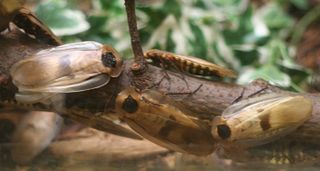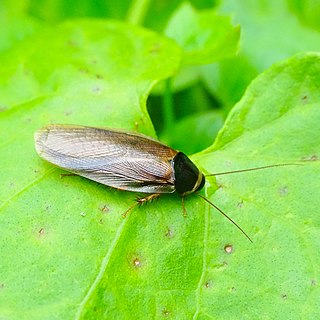
Blattidae is a cockroach family in the order Blattodea containing several of the most common household cockroaches. Some notable species include:

Ectobiidae is a family of the order Blattodea (cockroaches). This family contains many of the smaller common household pest cockroaches, among others. They are sometimes called wood cockroaches. A few notable species include:

Bandwings, or band-winged grasshoppers are the subfamily Oedipodinae of grasshoppers classified under the family Acrididae. They have a worldwide distribution and were originally elevated to full family status as the Oedipodidae. Many species primarily inhabit xeric weedy fields, and some are considered to be important locusts:

Supella is a genus of cosmopolitan and wild cockroaches, in the family Ectobiidae: originating from Africa and the Arabian Peninsula.

Blaberus is a genus of cockroaches generally found in South America. About 19 species are in the genus, and they are popular among hobbyists as feed for other arthropods or as pets. Unlike several genera of cockroaches considered to be pests, this genus keeps its ootheca in its abdomen until the time it hatches. They generally require a relative humidity of 60% or higher to thrive and temperatures above 25 °C to reproduce.

Trigonidiinae is a subfamily of insects in the order Orthoptera, suborder Ensifera, based on the type genus Trigonidium. They are often referred to as sword-tail crickets, winged bush crickets or trigs.

Diploptera, also known as the beetle cockroach, is a genus of blaberid cockroaches. Cockroaches of this genus resemble beetles, with hardened tegmina and cross-folded hindwings. They live in tropical forests in South China and Southeast Asia, and Pacific islands including Hawaii. They are viviparous cockroaches and are therefore used for insect endocrinological studies. There are eight known species and two subspecies.

The Phaneropterinae, the sickle-bearing bush crickets or leaf katydids, are a subfamily of insects within the family Tettigoniidae. Nearly 2,060 species in 85 genera throughout the world are known. They are also known as false katydids or round-headed katydids.

Panchlora is a genus of cockroaches.

Ectobius is a genus of non-cosmopolitan cockroaches native to Old World described by Stephens in 1835, belonging to the family Ectobiidae, subfamily Ectobiinae. This genus has been subject to a number of revisions.

Typophyllum is a genus of leaf-mimicking katydids belonging to the family Tettigoniidae.
Celatoblatta is a genus of cockroach in the family Blattidae containing a number of species from Australia, New Zealand and New Caledonia.

The Pseudophyllodromiinae are a subfamily of cockroaches, in the family Ectobiidae, with a world-wide distribution.
Epilampra is a genus of cockroach in the family Blaberidae. There are more than 70 described species in Epilampra.
Symploce is a genus of cockroach in the family Ectobiidae. There are at least 60 described species in Symploce.

Chorisoneura is a genus of cockroach in the family Ectobiidae. There are at least 90 described species in Chorisoneura.

Ischnoptera is a genus of cockroach in the family Ectobiidae. There are more than 90 described species in Ischnoptera.

Trigonidium is a large genus of sword-tail crickets, typical of the tribe Trigonidiini. Records of occurrence are from Europe, Africa, tropical Asia, Australia and the Pacific islands; many species endemic to Pacific islands including Hawaii have now been placed in the genus Nudilla.

Gryllacris is a genus of Orthopterans, sometimes known as 'leaf-folding crickets' in the family Gryllacridinae. It is the type genus for the family, tribe Gryllacridini and its subfamily.

Pycnoscelus is a genus of cockroaches in the family Blaberidae. There are about 15 described species in the genus Pycnoscelus.

















